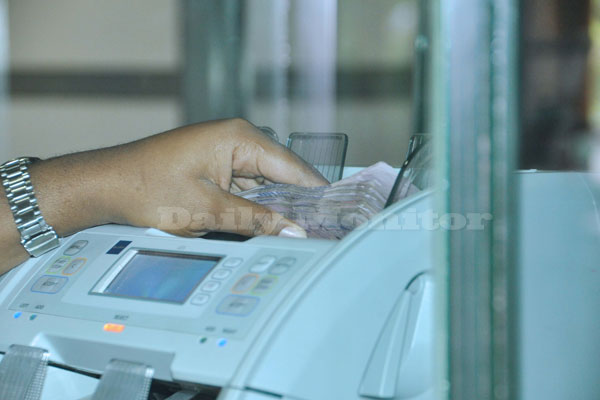How SME leasing can boost recovery

Money is passed through a money counting machine. PHOTO/FILE
What you need to know:
- Economic development. In Uganda, the SMEs constitute about 70 per cent of the economy and they contribute 20 per cent of the Gross Domestic Product (GDP)
As businesses try to recover from the negative impact of the Covid 19 pandemic and the subsequent lockdown, business analysts believe that Small and Medium Enterprises (SMEs) leasing should be put forward to hasten recovery.
The analysts note that SME leasing is a viable form of financing especially those looking to grow and recover.
Leasing is a possibility for SMEs to expand their access to short- and medium-term financing to expand their access to short- and medium-term financing. Leasing also refers to “a contract between two parties where one party (the lessor) provides an asset for usage to another party (the lessee) for a specified period of time, in return for specified payments”, according to (Fletcher et. al. 2005).
Mr Charles Ocici, executive director, Enterprise Uganda, says SME leasing is an option of financing assets typically for machinery.
“As part of collateral (machinery) that has been leased will constitute part of the collateral fees,” Mr Ocici says.
Examples of items SMEs can use for leasing include equipment such as those used in printing, farming and transport. Others include bakery and brick equipment among others.
Citing an example where an SME wants to have a tractor but does not have the money, the bank will give it to you but add a small collateral (security) that is worth the property. This is possible once an SME demonstrates that it can use it well.
The bonus about SMEs leasing is you do not need to have huge security for the tractor.
“As the lessee, you get to take part in selecting the kind of machinery you want. You also get to acquire knowledge especially if the lessor is experienced.”
He encourages SMEs into leasing to identify the market for their product and build production capacity.
“For leasing to work, you must have potential utilisation of the lease and should have a strong capacity of about 70 percent,” Mr Ocici adds.
Leasing offers an easy route to get superior machinery and expand businesses.
Mr Ocici explains that leasing can allow new businesses with limited capital and credit history or small businesses without a history of financial statements to quickly boost their operations, as long as the cash flow from operations is sufficient to cover the lease service payments.
Dr Adam Mugume, executive director research and policy, Bank of Uganda, says leasing is at infancy but “we have little information on what kind of businesses are participating.”
Mr Mugume, however, adds that most SMEs in Uganda would still be constrained to access leasing. Majority of the SMEs are informal and leasing, like all financial services, would require formal businesses.
Mr Adad Iraguha, head of commercial asset finance, Absa Bank Uganda, says Absa bank recognises the role the SMEs play in the economic development of the economy.
For instance, in Uganda, the SMEs constitute about 70 per cent of the economy and they contribute 20 per cent of the Gross Domestic Product (GDP). However, one of the challenges faced by SMEs is limited access to formal credit.
“At Absa, we offer both finance and operating leases to support SMEs. Under this arrangement, an SME does not have to provide collateral for the asset being financed. The financed asset becomes the principal collateral,” Mr Iraguha says.
This is done through bank partners with corporate companies to offer value chain solutions to SMEs while working with suppliers of motor vehicles and other assets to ensure that the SMEs access quality assets at cost friendly price and interest rates.
How SMEs benefit from leasing
There are two types of leases - finance and operating lease.
The type of the lease that may be suitable to an SME will depend on a number of factors, for instance, if the intention is to use or own, whether the SME wants to use the asset for a short term or long-term plus if they wish to contribute towards the purchase of the asset or not. These kinds of leases several benefits to SMEs.
Under leasing, the financed asset becomes the principal collateral.
“Most SMEs cannot access credit from formal financial institutions due to lack of collateral security. This problem is cured by leasing whereby if an SME purchases an asset, it acts as collateral,” he reveals.
But most SMEs have issues with cash flow. They don’t have enough money to purchase assets out rightly. Most of them lack credibility to access supplier credit since they cannot be trusted by suppliers.
He notes that leasing can be a solution for this challenge. An SME can access up to 80 per cent financing from a bank such as Absa bank.
In addition to the 80 per cent financing contribution, SMEs can access financing for other additional costs such as insurance and vehicle tracking.
The leased asset is the primary generator of the cash flows to repay the facility. “When an SME purchases an asset, it will help conserve cash (reduce cash outflow) or generate additional revenue (cash) in the business hence making leasing a perfect product for SMEs.”
Mr Iraguha further adds that SMEs benefit from low transaction costs associated with leasing. This means an SME does not have to meet the cost of valuations and security perfection among others.
Impact of Covid 19
Mr Iraguha notes that pandemic has created both challenges and opportunities in the asset financing space.
“Some SMEs have also collapsed since they cannot cope with the pressures of cash flows/lack thereof created by negative impact of Covid-19,” he explains.
“Some have struggled to pay their lease rentals and we have seen the lease instalments deferred or rescheduled through deliberate credit relief measures.




